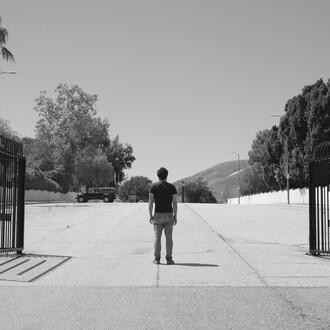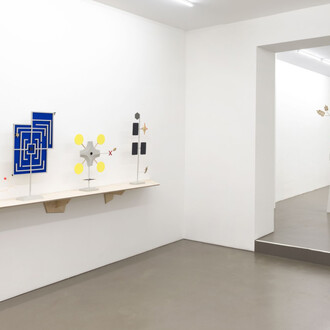The group exhibition Showcase shows works by 12 artists from the Galerie Eigen + Art programme, taking a broad view on the medium of sculpture - between object, space and idea - exploring it in all its diversity and materiality.
The multimedia works of Birgit Brenner (b. 1964) focus on complex social and personal conditions. They can be understood as visual fragments of larger conversations that open up spaces of narration. Brenner ques tions human-made structures and systems, especially in regard of their absurdity between innovation and destructive power.
In sculptures, textiles and prints, Maja Behrmann (b. 1994) compiles a repertoire of forms that is constantly expanding through reciprocating references to one another. Questions arise about possible connectivity and relations: What grows together? Which fragments remain separate? Only through superimpositions, omissions and spatial arrangements do previously invisible lines of connection become visible.
The artistic practice of Martin Gross (b. 1984) comprises drawings, texts and installations that take up the rapid flood of information and visual overload of the digital age and translate it into complex visual land scapes. In media such as oil pastels, LED panels and wall installations, word sketches and short texts appe ar again and again, inspired by file names, abbreviations, memes or advertising slogans.
Stella Hamberg‘s (b. 1975) sculptures always remain open to meaning and thus appeal to the productive power of imagination. At the same time, they maintain a neutrality, as any transformation and comple tion of the works remains the product of the viewer‘s intellectual and sensual activity. Hamberg reworks classical sculptural themes, gives them a new form and sets them in motion. Head, equestrian figure, animal figure, fragment, amorphous form are set in motion both formally and in terms of content and never seem to come to a standstill.
Stef Heidhues (b. 1975) groups sculptures and wall objects into walk-in pictorial spaces in expansi ve settings. The starting point is usually everyday objects and the examination of public and social spaces. Information that has been rendered unrecognisable deliberately creates ‘blank spaces’ that focus attention on what is hidden or left out and pose questions about visibility, access and represen tation in an urban context.
The works of Melora Kuhn (b. 1971) draw on a visual language from mythology and history and often place individual pictorial motifs from American art history in new contexts. Kuhn‘s interest is focussed on those moments that are overlooked or excluded in dominant narratives. Through subtle interventions in the de piction, the works open up established biographies to new readings.
Eric Meier (b. 1989) uses the media of photography and sculpture to reflect on urban situations and elements of history and the search for identity. Glass blocks and exposed aggregate concrete, once symbols of stability and progress, appear deformed and transformed in Meier‘s work. Destruction, appro priation and reorganisation characterise his works, mirroring a sense of urban aesthetics.
Lada Nakonechna (b. 1981) confronts viewers with images of current events and collective memory in drawings, installations, videos and performances. The work The so-called shows crumpled paper, imprinted with terms such as Terrorists, Rebels or Punisher, lying unnoti ced on the floor. Like projectiles, they point to conflict and confrontation - ready for use, but their meaning remains vague.
In his artistic work, Carsten Nicolai (b. 1965) explores the interface between art, science and sound. The sculpture void A/B captures disembodied sound inside and transforms it into a physical object. Even if the information stored in the sound is neither visually comprehensible nor can it be written down, it is preserved through materiality and form.
Olaf Nicolais (b. 1962) works from the FOG series were first exhibited in 2017 in the exhibition Der 673. Morgen. In the artist‘s book accompanying the exhibition, Das Märchen der 672. Nacht by Hugo von Hofmannsthal was collaged with collages of advertisements for real estate investments and private banking, framed by a short text that can also be read in relation to object collages FOG, which present the theme of visibility very directly in title and form.
Nicola Samorì‘s (b. 1977) work is in dialogue with Italian Baroque painting of the 17th century, although the finished work is always held back, the surface deliberately destroyed or attacked. The sculpture Lieve legno transfers the form of a medieval plaster figure of a saint into the organic material of a found cypress trunk, but the vertical tension of the work stretches the figure to the limits of its anthropomorphic legibility.
Kai Schiemenz (b. 1966) is interested in the relationship between the city, space and architecture and their regulating function on people. His sculptures made of cast and mouth-blown glass are architecturally con ceived structures and construct permeable spaces via visual axes that directly involve the viewer and allow them to become a physical and conceptual part of the work.
















